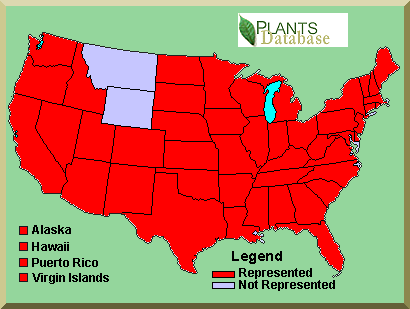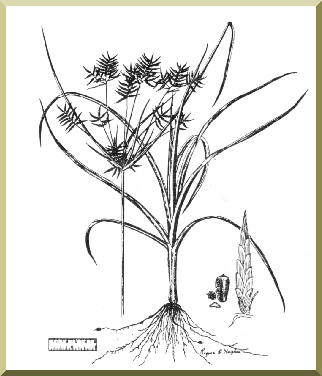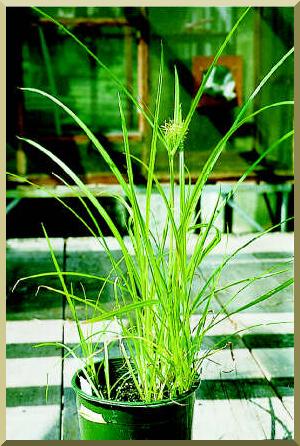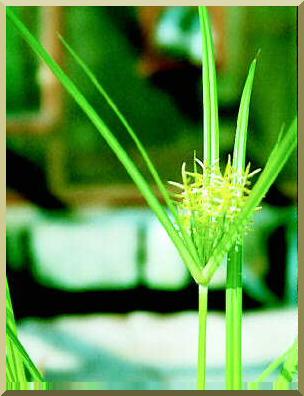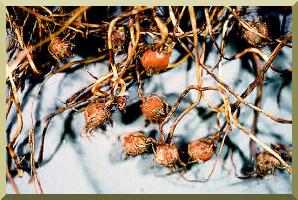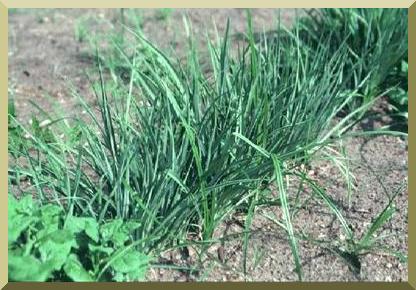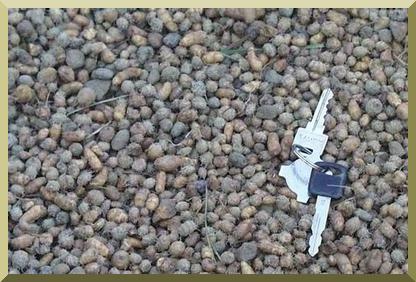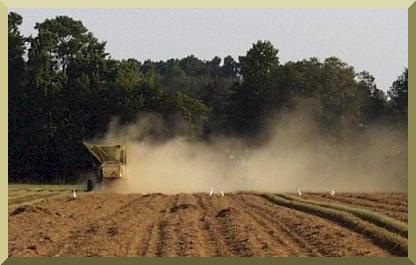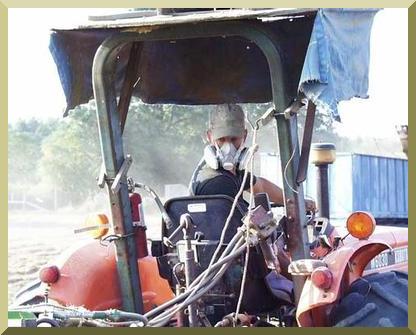|
|
|
|
| 2. YELLOW NUTSEDGE |
|
Yellow nutsedge is found worldwide in warm and temperate zones, occurring in Europe and Africa. It was introduced into the New World from the Old World. In the Western Hemisphere, it grows from southern Canada to northern Argentina. The plant is known in most of the United States, except Wyoming and Montana (see map). It occurs elsewhere in the world in regions with temperate to tropical climates. Yellow nutsedge is a noxious weed of wet soil. The nutsedge is most difficult to control in cultivated soils, often forming a solid cover over large areas in cotton fields, sorghum and alfalfa pastures, flood plains, dams, ditches, and along streams and roadsides. In Arizona, it is common throughout most of the state, from 100 to 8200 ft elevation, flowering from May to November. In California it occurs throughout the state, up to elevations of 1000 m.
|
|
|
|
|
2.2 Characteristics Yellow nutsedge is a tough erect fibrous-rooted perennial, 1 to 3 ft high, reproducing by seeds and by many deep, very slender rhizomes, which form weak runners above the ground, and small tubers or nutlets at the tips of underground stems. The tubers are dark, unevenly globed shaped, 3/8 to 3/4-inch long, and edible, tasting somewhat like almonds. Near the base of the triangular yellow-green stem, a cluster of three-ranked, grasslike leaves arises which are often longer than the stems, and 1/8 to 1/3-inch broad. The umbrella-like flowering tops have a few threadlike stems of different lengths radiating out like spokes from the stem tip. These have numerous yellowish to golden-brown spikelets on the upper part. The spikelets are very narrow, flattened, 1/16 to 1/12-inch broad, and 1/4 to 1 1/2-inch long. The leaves beneath the flowering tops are 2 to 10 inches or more long, and some are much longer than the flowering stems. The brownish three-angled achene, about 1/16-inch long, is widest at the top. The nutlets are almost smooth at maturity and unevenly globe shaped. Yellow nutsedge grows from perennial tuber-bearing rootstocks; the tubers are approximately 2/5 to 4/5-inch long. The leaves are narrow and grass-like, growing in three vertical rows on the stem. Most of the leaves are clustered at the base of the stem. The small flowers are yellowish or yellowish-brown, and arranged in narrow spikelets on umbel-like inflorescences (group of flowers originating from a single point). Located immediately below the inflorescence are 3- to 9-inch long leaf-like structures (bracts). The flowers have three stamens and a three-cleft style. The yellowish-brown seeds are about 1/16-inch long and three-angled.
|
|
|
|
2.3 Growth and Development The yellow nutsedge plant forms tubers in the summer and autumn. The tubers, which are formed at the apical ends of indeterminate rhizomes, usually sprout the spring after they are formed. Tubers generally produce one to three sprouts (determinate rhizomes), which grow toward the soil surface and form a primary basal bulb just below the surface. Each primary basal bulb produces a vegetative plant. The basal bulb produced by the original tuber has many fibrous roots and indeterminate rhizomes; the indeterminate rhizomes may then develop into secondary basal bulbs and tubers. When a critical daylength or temperature is reached, plants stop growing vegetatively and start to flower; however, many populations do not produce viable seed. Tubers are the only part of the plant that overwinter. Winter conditions kill basal bulbs, rhizomes, fibrous roots, and all above-ground parts. While tubers may be viable up to 3.5 years, most only survive one winter. |
|
|
|
2.4 Reproduction Yellow nutsedge does produce seed; however, reproduction by seed is of minimal importance in most areas in comparison to vegetative spread. The species spreads primarily by tubers, rhizomes, and corn-like basal bulbs. Tubers planted to soil depths of 80 cm produced new plants. Tubers survive soil temperatures as cold as -5oC and require a period of chilling to break dormancy and germinate. Tubers germinate when soil temperatures remain above 6oC. Under field conditions, tubers typically survive approximately 3-4 years. Yellow nutsedge is considered one of the world's worst weeds. Well adapted to irrigated agriculture, yellow nutsedge is particularly problematic in row crops because it competes with crops for water, light, and nutrients, thereby reducing crop yield. It has also been known to spoil the quality of some crops. In some areas, yellow nutsedge tubers have been known to grow into potato tubers causing them to be graded as culls. They may also pass through shelled lima beans, requiring costly hand sorting. It addition, there has been some suggestion that this species may produce chemicals that are toxic to crops. 2.5 Economic Importance Yellow nutsedge is closely related to chufa (Cyperus esculentus variety sativus); some taxonomists treat them as the same species. In parts of Africa, Europe and Asia, chufa is grown for its edible tubers. The tubers contain protein, carbohydrates, sugars, and lots of oil and fiber. The chufa nut is good for human health, containing high levels of iron and potassium, and no sodium. The Spanish produce a drink called "horchata" made out of the nuts (tubers) of the yellow nutsedge. The popularity of this drink has recently extended to other countries such as France, Great Britain, and Argentina. Chufa tubers are ground into flour, as well as being used to produce a cold drink (horchata), a coffee substitute, vegetable oil, and cellulose. In the United States, the primary use of chufa as a crop is to attract and feed game, particularly wild turkeys. Turkeys love chufa tubers; as natural scratchers, once discovering a plot of chufa, they will return again and again, all winter long, or until spring arrives and other food is readily available. Chufa tubers have been planted so that pigs could be turned into the fields to fatten and improve the taste of pork. In the United States, chufa tubers have been used as hog feed, pastured in the field in states such as Florida, Georgia, and Alabama. Tubers of chufa have also been identified as valuable food for waterfowl and cranes. Ducks dive for them when wetland fields are flooded. Chufa is also used in seed mixes for wetland restoration, mitigation, and erosion control. Currently, yellow nutsedge is merely regarded as another obnoxious weed; however, historically, its small tuberous rhizomes were used both as food and medicine by the Native Americans. Even today the Egyptians cultivate a native species of Cyperus in moist soils or sandy shores for their edible tubers. These are called "tiger nuts" and are first fried, and then soaked in water. Reportedly, the taste is similar to hazelnuts. It was another species (C. papyrus) that the Egyptians used to make paper, sails, cloth. mats, ropes, or plaited into sandals. In the Peruvian Amazon, reportedly there is a native species of Cyperus used widely by tribal women as a natural contraceptive. This property has been attributed to a certain mold that grows on the root of the Amazonian species that has oxytoxic (abortive) properties similar to Ergot, a fungus that grows on rye. In Maradi state, eastern Niger, C. esculentus is cultivated for export to Nigeria. Revenues from this weed exceed those from the typical cash crops such as cowpea and groundnut. The tubers of C. esculentus may be consumed raw, roasted, or ground.
Nowadays, chufa is cultivated in Northern Nigeria and Ghana, where it is made into a sweet meat, and Togo, where it is used uncooked as a side dish. These countries, and others as the Ivory Coast, export 2300 tons of tubers every year to Spain. The chufa is also a representative crop of the Spanish Mediterranean region, where tubers are used to make a beverage called horchata or horchata de chufas. The milky-looking aqueous extract of chufa has a pleasant and characteristic flavor of vanilla and almonds. Chufa is potentially a commercial source of high-oleic acid vegetable oil and high-carbohydrate tuber cakes. Some authors believe that tuber oil could be exploited in the same way as olive oil. Chinese researchers have measured the physical and fuel properties of oil extracted from the chufa, and concluded that the physical properties are similar to those of other vegetable oils. They have suggested that this oil may also be used as biodiesel fuel.
Products from the chufa tubers include aqueous solutions (as a base for non-alcoholic beverages), milky solutions (as refreshing beverages or partial milk substitutes), as well as cookies and ice-cream made with chufa. The caramel from malted tubers of Cyperus esculentus may be used to add body, flavor, or color to certain baked products, non-alcoholic malt beverages and dark beers, and in the production of condiments. The starches obtained from chufa and rice showed similar properties; the solutions of the starch exhibited a good paste stability, clarity, and adhesive strength. The starch can be used in many starch-based foods as well as in the cosmetic industry, and for laundry, glazing and stiffening. The waste residue after oil extraction could be further modified producing syrups, flours, or livestock feeds.
Chufa tubers have a relatively high total antioxidant capacity, because they contain considerable amounts of water-soluble flavonoid glycosides. Consumption of antioxidants could protect the immune system of malnourished populations. The intake of antioxidant-containing foods may delay the progression of HIV infection to AIDS. For many years, the chufa tubers have been considered to have adequate properties to fight respiratory infections, and some stomach illnesses. To this date, the "horchata de chufas" is considered an effective remedy for diarrhea, according to popular tradition in Valencia, Spain. |
|
2.6 Cultivation Chufa is planted in late spring to midsummer by dropping the dried tubers 6-12 inches apart in rows spaced 2-3 feet apart. The planting rate is 15-40 pounds per acre. The tuber develops into a plant which has several tubers bunched together directly beneath it, the plant and a few straglers some distance away. Although bunched together, each nut is attached to a thin underground stem that connects the single tuber to the growing shoot. Chufas are easy to grow and require almost the same care as corn. Experience in Northwest Florida suggests that chufa plots should be no less one acre, and preferably 2-5 acres. Very small plots may be damaged or destroyed by raccoons, crows, skunks, deer or squirrels. Raccoons, crows and skunks will dig up young plants to eat the tubers. Deer and squirrels will eat the tubers if they are exposed. Chufa may be planted in woodlands to encourage populations of wild turkey and deer. Planting time must allow 90-100 days frost-free growing time. In Northwest Florida, chufa is planted from April to early August. Earlier plantings seem to higher yield but require more cultivation or herbicide protection. Later plantings tend to last longer into the next winter, which is desirable. Chufas grow best in sandy-loam soils but will grow in the hardest clay.
At the end of the planting season, when chufa tops have died down, a clumps should be turned over for the first-time turkeys to find. After they have located the plot, they will scratch it up and notify the next of kin, who will return to dig up and eat the tubers. Since 1978, a number of research studies have been carried out related to the cultivation of chufa. The date of cultivation of chufa tubers has varied throughout time. Formerly tubers were usually planted at the beginning July, after the wheat harvest. Later, planting started in June and more recently, the first fortnight of May. In the early 1980s, most farmers preferred to plant tubers even earlier in the year to increase production. The influence of soil texture on the amount and quality of tubers has also been studied. The most appropriate soil texture for chufa cultivation is sandy-loam.
|
|
2.7 Chemical Control The chemical control of yellow nutsedge is described in the following tables.
|
| Herbicides | Turfgrass | Ornamentals | Cool-season grasses |
| Preemergence | Pennant | Pennant | Basagran T/O, Daconate 6 |
| Post-emergence | Basagran T/O, Daconate 6, Image | Basagran T/O, Roundup | Basagran T/O, Daconate 6 |
| Herbicides | Bermuda grass | Centipede grass | St. Augustine grass | Zoysia grass |
| Preemergence: Metolachlor | yes | yes | yes | yes |
| Post-emergence: Bentazon | yes | yes | yes | yes |
| Post-emergence: Halosulfuron | yes | yes | yes | yes |
| Post-emergence: Imazaquin | yes | yes | yes | yes |
| Post-emergence: Imazaquin + MSMA | yes | no | no | yes |
|
2.8 Other Controls It is best to target control efforts in the year before planting. Use of a cereal crop or cover crop that shades the soil is recommended, as nutsedge does not tolerate shade very well. Rotation to a crop where Dual or Frontier can be incorporated before planting is recommended. The incorporation into the soil puts the herbicide down where the tuber will germinate from, inhibiting new shoots. Preliminary results show that a single top burndown at 30 to 45 days is not enough to prevent further tuber development. However, if topgrowth is controlled for a full year, tuber numbers will be reduced up to 90%. The farmer needs to look for opportunities to burn down the nutsedge before the nutlets begin to form in July. For late-planted crops, the tops should be destroyed before planting, or after an early harvested crop, the topgrowth should be destroyed immediately after harvest. In the non-crop period, Gramoxone, Ignite, or Roundup will kill tops. Basagran is also effective in killing tops. Nutsedge is usually dragged into a field on tillage equipment. Nutsedge moves into crop fields from edges near ditches and roadsides. New patches should be targeted before they get to be a problem.
|
| General | Purple Nutsedge | Comparison | Sustainable Control Strategies |
| Strategies for the Ojos Negros Valley | Summary | Coquillo Facts |
|
http://ponce.sdsu.edu/three_issues_coquillofacts02.html
|
021104 |


